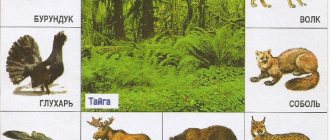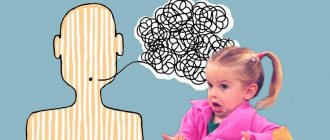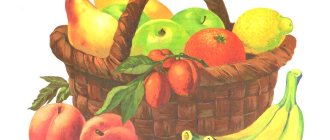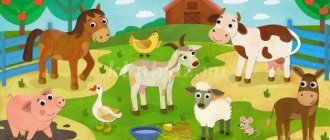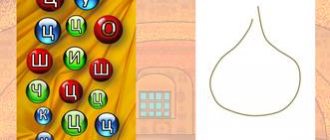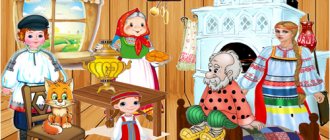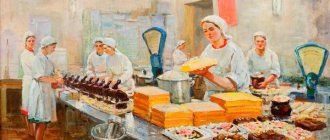Notes on speech development “Transport”
Subject:
Transport
Target:
generalize and systematize the idea of transport, activate vocabulary on this topic, the practical use of prefixed verbs and compiling a short descriptive story using questions.
Program content:
Developmental task:
Teach children to generalize and classify vehicles: cargo, passenger, fine motor skills, coordination of speech with movement, visual attention and perception.
Educational
speech tasks:
compose a descriptive story about this transport toy using questions:
- practice the practical use of words with affectionate and magnifying connotations;
- practical use of prefixed verbs;
- agree nouns with adjectives in number, gender, case;
- learn to compose a whole from parts (cut pictures).
Corrective task:
train children in the use of feminine and masculine nouns; expand your vocabulary on the topic “transport”.
Educational task:
teach children the rules of behavior in public transport through playful images.
Materials:
toys transport, pictures of transport, cut-out pictures of transport, audio recording “Bus”, panorama of the city with images of transport.
Progress of the lesson
— Guys, how did you get to kindergarten today, who lives far away, what? (On foot, car, bus)
- Those who live next to the kindergarten came on foot, those who live far from the kindergarten - went by bus, car, taxi (the teacher places the corresponding pictures on the magnetic board). What is a car, a bus, a taxi? (Transport)
— What are the people who travel in passenger transport called? (Passengers)
— What is the name of the machine that helps transport cargo? (Cargo)
— What kind of cargo can trucks transport (Furniture, sand, snow, food, gasoline, milk, etc.)
Pay attention to the panorama of the city, consider the image of transport. Finger game “Let’s count.”
We will bend our fingers - (clench and unclench our fingers) We will name transport: Car, taxi, Tram, metro, bus (unclench our fingers, starting with the little finger) We clenched 5 fingers into a fist, named 5 types of transport. (clench your fingers into a fist, starting with the thumb).
— Who drives passenger and cargo transport (driver, driver).
Generalization from the teacher: Cars are our helpers, but without a driver they cannot work. The driver must know well the structure of his car and its parts.
- Do you know what main parts it consists of?
— What is the name of that part of the car where the driver sits and controls the car? (Cabin)
—Where do they put the cargo? (Body)
— Where do the passengers sit? (Salon)
— Without which part will the car never move? (Without wheel)
Game exercise “Riding on the bus”
“Now let’s all take a ride on the bus together.” Who will we be on the bus? (Passengers). How should passengers behave on the bus and why?
I will speak, and you answer:
— The bus has left
), to another stop (
arrived
).
Then he climbed up a small hill ( drove in or drove over
) and together with us he bridged (
moved over
).
He quickly entered the tunnel ( drove
) and from there soon to a gas station (
went, arrived
).
Speech game “At a gas station”
All the cars in order arrive at the gas station. (with both hands “turn the steering wheel” in front of you) A fuel truck, a garbage truck, a milk truck with milk, a grain truck with fresh bread, and a heavy timber truck.
(Fingers alternately, starting with the little finger, touch the palm).
Having refueled, the bus to the exhibition-salon ( arrived, stopped
).
— An exhibition-salon of vehicles “Funny Motors” opened in our group. I will be the director, and you will be the car sales managers. You must tell us about the transport you like and advertise it:
Car name.
What is she like: describe her appearance, color.
Name the parts.
What is it intended for?
— I’ll start with advertising: This is a bus. He is red. It has a cabin, wheels, many windows, doors. The bus carries passengers.
Listen to 3-4 stories.
- Guys, in the distant fairy-tale country of “Liliput” there live little people and everything they have is small: clothes, shoes, and transport.
Game exercise “Big-small”
| Educator | Children |
| car | machine |
| automobile | car |
| truck | truck |
| tram | tram |
| trolleybus | trolleybus |
| bus | bus |
Cars are our faithful and reliable assistants. But in order for them to serve for a long time, they need to be looked after, repaired, and placed in the garage.
Didactic game “Fix the car”
The drivers pressed hard on the pedals, the car fell apart into parts. Help, help, assemble a car from parts.
Children assemble cars piece by piece (from cut-out pictures). At the end they say what they did.
And now I’m turning you into a machine, whoever wants what kind. And each of you will leave the lesson with your own signal. Verbal game “Pretend to honk your car’s horn” (honk your horn loudly for goodbye, honk quietly for the cars to drive far away).
Summary of a lesson on speech development on the topic “Transport”
Goal: To clarify and consolidate children’s ideas about transport.
Tasks:
Correctional and educational. Clarify and activate vocabulary on the topic “Transport”. Learn to compose sentences with the prepositions B and NA. Learn to compose coherent descriptive stories using a diagram.
Correctional and developmental. Develop coherent speech. Develop logical thinking. Develop speech breathing and voice.
Educational. Cultivate interest in the activity. Foster independence, activity, and a sense of teamwork.
Equipment. Magnetic board, subject pictures, diagram for a descriptive story, cards with faces, pencils.
Progress of the lesson
I. Motivational component
1. Academic Hello guys! The sun is smiling at you, so that you are in a good mood, let's smile at each other! 2. Uch. Guess the riddle. There is both water and air, the one that moves on land, carries cargo and people. What is this? Tell me quickly! D. Transport. Uch. Right! Have you guessed what the topic of our lesson today is? D. Yes, transport. Uch. Right! The topic of our lesson is “Transport”. A picture of transport is posted on the board. Uch. Let's remember the types of transport while doing exercises. An airplane is flying: pronouncing the sound [l] - [l] - [l]. The steamer is humming: pronouncing the sound [s] - [s] - [s]. The tire of the car has punctured: pronouncing the sound [w] - [sh] - [sh]. Pump: pronouncing the sound [s] – [s] – [s]. Cars drive along the wet pavement: pronouncing the syllables “sha - shu - shi - sho.” The car honks: pronouncing “bi-bi-bi” on one exhale. The train is humming: pronouncing “tu-tu-tu” on one exhale. Uch. Well done!
II. Operational Component
1. Academic Now I will name correct and incorrect sentences, and you listen carefully and correct me if I say incorrectly. A car is a ground vehicle.
D. Correct. Uch. A steamship is an air transport. D. Incorrect. A steamship is a water transport. Uch. The train is controlled by a pilot. D. Incorrect. The train is driven by the driver. Uch. What does the pilot control? D. By plane. Uch. Well done! Now we will play the game “Which transport is better?” We will divide into 3 teams: 1st row - 1st team, 2nd row - 2nd team, 3rd row - 3rd team. Row 1 will talk about the bus, row 2 about the train, row 3 about the tram. You will take turns providing evidence that your transport is better. 1 team starts. D. Inexpensive travel. Uch. 2nd team. D. Transports a lot of people. Uch. Team 3 D. Moves using electricity. Children take turns giving arguments. Uch. Well done! Let us conclude that each type of transport has its positive sides.
2. Uch. Let's warm up a little.
Physical school Hands to the sides - take flight We send the plane. (Arms to the sides.) Right wing forward, (Turn over the right shoulder.) Left wing forward, (Turn over the left shoulder.) Our plane flew. (Hands to the side.)
3. Uch. Look at the picture. Who and what is depicted on it?
D. Cats, dogs, horses, cows; bus, tram, trolleybus, taxi. Uch. Tell me, who's coming in? D. Cat, cow. Uch. Who's going? D. Dogs, cats, horses. Uch. Make up sentences. Who goes where? D. The cat gets on the bus. The cow enters the taxi. Uch. Who's riding what? D. Dogs ride on a tram. Cats travel by bus. Horses ride on a trolleybus. Uch. Remember: The cat gets on the bus. The cat rides on the bus.
4. Uch. Now we will learn to ask and answer questions. Listen to the sample. What will you drive to visit? I'll go visit by metro. Take turns asking each other questions.
Children complete the task. Uch. Well done!
5. Uch. Now we will compose stories according to the scheme. Everyone thinks of any type of transport, describes it according to a diagram, but does not name it. Everyone else will have to guess. Look at the diagram. You must
answer the following questions:
- What parts does it consist of?
- What sets it in motion?
- Where is this transport going?
- What is it used for?
- Who operates this type of transport?
Presentation of children's works. Observing children's speech. Error correction.
This vehicle consists of a body, wheels, steering wheel, seats, and windows. This vehicle is powered by gasoline. This vehicle moves on the ground. It is used to transport people. It is controlled by a driver. (Bus) Uch. Well done!
III. Regulatory Component
Uch. What topic did we study today? D. Today we studied the topic “Transport”. Uch. What have you learned? D. We learned to compose stories according to a diagram. Uch. Did you like the lesson? D. Yes! Uch. You have cards with different faces on your desk. Color the one that suits your mood. Children complete the task. Uch. You worked very well today! Thanks for the activity!
Literature
T.P. Bessonova, O.E. Gribova Development of speech. Textbook for the preparatory class of special (correctional) educational institutions of the V type (1st department). - M.: Education, 2000 (pp. 88-89).
Author of the material: Shabanova Ekaterina Sergeevna
Also on topic:
Formation of a holistic picture of the world, expansion of horizons in the middle group on the topic “Transport”
Article:
Topic: Transport
Purpose: to generalize and systematize the idea of transport, to activate vocabulary on this topic, the practical use of prefixed verbs and compiling a short descriptive story using questions.
Program content:
Developmental task: Teach children to generalize, classify vehicles: cargo, passenger, fine motor skills, coordination of speech with movement, visual attention and perception.
Educational speech tasks: compose a descriptive story about this transport toy using questions:
- practice the practical use of words with affectionate and magnifying connotations;
- practical use of prefixed verbs;
- agree nouns with adjectives in number, gender, case;
- learn to compose a whole from parts (cut pictures).
Corrective task: to train children in the use of feminine and masculine nouns; expand your vocabulary on the topic “transport”.
Educational task: to teach children through game images the rules of behavior in public transport.
Materials: toys transport, pictures of transport, cut-out pictures of transport, audio recording “Bus”, panorama of the city with images of transport.
Progress of the lesson
— Guys, how did you get to kindergarten today, who lives far away, what? (On foot, car, bus)
- Those who live next to the kindergarten came on foot, those who live far from the kindergarten - went by bus, car, taxi (the teacher places the corresponding pictures on the magnetic board). What is a car, a bus, a taxi? (Transport)
— What are the people who travel in passenger transport called? (Passengers)
— What is the name of the machine that helps transport cargo? (Cargo)
— What kind of cargo can trucks transport (Furniture, sand, snow, food, gasoline, milk, etc.)
Pay attention to the panorama of the city, consider the image of transport. Finger game “Let’s count.”
We will bend our fingers - (clench and unclench our fingers) We will name transport: Car, taxi, Tram, metro, bus (unclench our fingers, starting with the little finger) We clenched 5 fingers into a fist, named 5 types of transport. (clench your fingers into a fist, starting with the thumb).
— Who drives passenger and cargo transport (driver, driver).
Generalization from the teacher: Cars are our helpers, but without a driver they cannot work. The driver must know well the structure of his car and its parts.
- Do you know what main parts it consists of?
— What is the name of that part of the car where the driver sits and controls the car? (Cabin)
—Where do they put the cargo? (Body)
— Where do the passengers sit? (Salon)
— Without which part will the car never move? (Without wheel)
Game exercise “Riding on the bus”
“Now let’s all take a ride on the bus together.” Who will we be on the bus? (Passengers). How should passengers behave on the bus and why?
I will speak, and you answer:
— The bus from the stop ( departed ), to another stop ( arrived ). Then he climbed a small hill ( drove in or drove over ) and together with us he bridged ( moved over ). He quickly entered the tunnel ( drove ) and from there soon to a gas station ( went, arrived ).
Speech game “At a gas station”
All the cars in order arrive at the gas station. (with both hands “turn the steering wheel” in front of you) A fuel truck, a garbage truck, a milk truck with milk, a grain truck with fresh bread, and a heavy timber truck.
(Fingers alternately, starting with the little finger, touch the palm).
Having refueled, the bus went to the exhibition-salon ( arrived, stopped ).
— An exhibition-salon of vehicles “Funny Motors” opened in our group. I will be the director, and you will be the car sales managers. You must tell us about the transport you like and advertise it:
Car name.
What is she like: describe her appearance, color.
Name the parts.
What is it intended for?
— I’ll start with advertising: This is a bus. He is red. It has a cabin, wheels, many windows, doors. The bus carries passengers.
Listen to 3-4 stories.
- Guys, in the distant fairy-tale country of “Liliput” there live little people and everything they have is small: clothes, shoes, and transport.
Game exercise “Big-small”
| Educator | Children |
| car | machine |
| automobile | car |
| truck | truck |
| tram | tram |
| trolleybus | trolleybus |
| bus | bus |
Cars are our faithful and reliable assistants. But in order for them to serve for a long time, they need to be looked after, repaired, and placed in the garage.
Didactic game “Fix the car”
The drivers pressed hard on the pedals, the car fell apart into parts. Help, help, assemble a car from parts.
Children assemble cars piece by piece (from cut-out pictures). At the end they say what they did.
And now I’m turning you into a machine, whoever wants what kind. And each of you will leave the lesson with your own signal. Verbal game “Pretend to honk your car’s horn” (honk your horn loudly for goodbye, honk quietly for the cars to drive far away).
